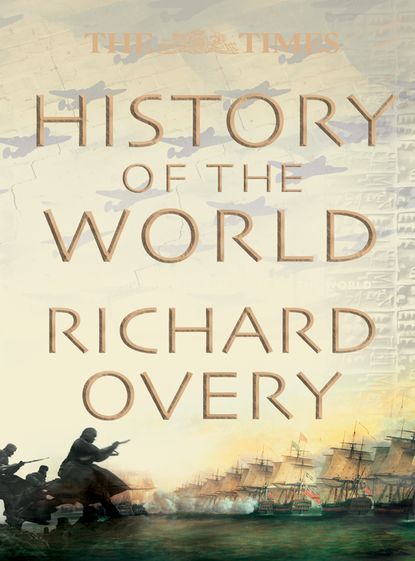По всем вопросам обращайтесь на: info@litportal.ru
(©) 2003-2024.
✖
The Times History of the World
Настройки чтения
Размер шрифта
Высота строк
Поля
EXPANSION AND DISUNITY
During the New Kingdom, military conquests created an Egyptian empire stretching from the Euphrates in the north to Nubia in the south. Within Egypt, imperial expansion was matched by magnificent construction works of tombs and temples. The cult of the most important god Amun-Re was temporarily set back when Akhenaten (c. 1364–1347 BC) built a new capital at Amarna, where the worship of the Aten or solar disc was promoted.
Under Rameses II Egypt reached a pinnacle of wealth and power, but there are clear indications that from the reign of Rameses III onwards there were growing external and internal problems. Egypt’s empire in Syria and Palestine was lost. Its eastern and seaward borders were threatened by the sea peoples. On the western border, despite the victories of Rameses III, the Libyans posed a continuing and destabilizing problem. Internally, royal power was eroded by such factors as weak rulers, administrative inefficiency and the growing authority of the high priests of Amun at Thebes. By the end of the 20th Dynasty (c. 1069 BC) Egypt was once again a disunited land.
1600–1000 BC
THE NEAR EAST
The period after 1600 BC saw the fertile lands of Mesopotamia and the Levant become the battleground between rival empires: Hittites, Mitannians, Assyrians, Babylonians, Elamites and Egyptians. After 1200 BC, however, these powers collapsed in a dramatic sequence of events that is still not fully understood by historians. The resulting two centuries of upheaval marked the end of the Bronze Age in the Near East.
Much of the detailed knowledge of the relationships between the warring empires comes from the “Amarna letters”. This collection of documents written in Akkadian (the international language of diplomacy in this period), consists of correspondence between the Egyptian pharaohs Amenophis III, Akhenaten and Tutankhamun (1390–1327 BC) and the rulers of the other great powers. The letters reveal the dynastic marriages and gift-giving that typify relations between rulers: the personal and the political were intimately bound together.
The most important new power in the region was the Hittite empire in central Anatolia. The Hittites had been expanding their power from their centre at Hattushash since the reign of Hattusili I (c. 1650–1620 BC). Mursili I (c. 1620-c. 1590 BC) led an expedition that destroyed Aleppo and Babylon, but it was Tudhaliya I (c. 1420–1400 BC) and Suppiluliuma I (1344–1322 BC) who made the Hittites an imperial power. The empire consisted of a large number of small territories governed by client kings who owed their position entirely to the “Great King” who ruled from the capital, Hattusa. Client rulers were required to raise troops for the king’s campaigns, and to provide labour and goods for the central administration. They were often bound to the king by marriage ties.
The Hittites faced frequent pressure on their borders from Arzawa to the west and the Gasga to the north, but their biggest rivals were Egypt and the kingdom of Mitanni to the south. Mitanni first appears in the historical record in c. 1480 BC, when its ruler, Parrattarna, is described as controlling Aleppo. For the next 140 years Mitanni was a major power, controlling Assyria by 1400 BC. Mutual concern about Hittite power saw an alliance between Mitanni and Egypt, and the last independent ruler of Mitanni, Tushratta, married his daughter to Amenophis III and, after the pharaoh’s death, to his son Amenophis IV (Akhenaten). Tushratta was assassinated in c. 1340 BC, and his son Shattiwaza was installed as a vassal of the Hittites. Hostility continued between the Hittites and the Egyptians, leading to the great but inconclusive battle of Kadesh in 1275 BC between the pharaoh Rameses II (1279–1213 BC) and the Hittite king Muwatalli (1295–1271 BC).
Assyrian expansion began under Ashur-uballit I (1353–1318 BC), as Mitanni began to collapse under Hittite pressure. Adad-nirari I (1295–1264 BC) seized what was left of Mitanni from the Hittites, and Assyrian power grew to its greatest extent in the reign of Tikulti-ninurta I (1233–1197 BC), who conquered Babylon and installed a series of puppet rulers. Up until then Mesopotamia had been through a period of stability, ruled from Babylon, which came under the control of the Kassites in c. 1595 BC. Little is known about their origins, but they were noted for their horses and chariots, and maintained power for four centuries.
The Assyrian attack on Babylon led to counter-attacks from Elam to the southeast. The Elamite kings Kiden-Hutran (c. 1235–1210 BC) and Shutruk-Nahunte (1185–1155 BC) led campaigns into Mesopotamia, the latter capturing Babylon. Despite a Babylonian revival under Nebuchadnezzar I (1126–1205 BC), the general upheaval that brought an end to the Bronze Age saw both Babylon and Elam more or less disappear from the historical record within a few years.
Around 1200 BC there was a wave of destruction throughout the eastern Mediterranean from Greece to Syria and Palestine. Fifty years later several cities in Mesopotamia were also destroyed. There are reports from the city of Ugarit of attacks from the sea, and the Egyptian pharaohs Merneptah (1213–1203 BC) and Rameses III (1184–1150 BC) describe battles with “sea peoples”. Although this obscure group was once considered the cause of widespread destruction it is now thought that they were merely taking advantage of a widespread breakdown in political organization. Earthquakes, drought, interruption to the supply of metals, and many other things, have been suggested as the cause of the collapse. It is likely that no one explanation will suffice, and that a number of external factors, combined with the fragility of the centralized power structures of the Bronze Age kingdoms, led to the dramatic end of the civilizations of the Bronze Age.
300 BC TO AD 1300
PEOPLES OF SOUTH AMERICA AND
THE CARIBBEAN
By 300 BC most people in South America had become farmers, although some hunter-gathering persisted in the southern part of the continent where farming was difficult. By 750 BC, complex societies were developing in the Andes. As in Mesoamerica, they went through phases of growth and decline, but in the central Andes there was a degree of cultural unity in that artistic differences between the highlands and lowlands were not as marked.
SOUTH AMERICA
The coast of the central Andes is best known, archaeologically, for the graphic pottery of the Moche, dating from AD 100 to 600. It reveals much about daily life and religion. The Moche were the first to assert themselves more widely by conquest. Both pottery and tombs show that, like their contemporaries in Mesoamerica, Moche kings exhibited their authority in elaborate rites.
Yet from about AD 600 the coast succumbed to conquest from the Tiahuanaco and the Huari. Both these civilizations developed elements of the earlier Chavín cult (see p. 19). The city of Tiahuanaco was centred on the Titicaca Basin in Bolivia where the people grew potatoes and herded llamas and alpacas. Renowned for their stone buildings and sculpture, their expansion seems to have been achieved through the establishment of religious and commercial colonies. The reasons for its collapse about AD 1200 are not fully understood, but may have been related to climate change that affected agricultural production. The Huari are often considered to have been the precursors of the Inca. Among the hallmarks of Huari civilization was a network of roads and logistical, perhaps administrative, bases. Following two centuries of political fragmentation, the Moche tradition was revived among the Chimú, consummate engineers who developed vast irrigation systems. They controlled parts of the Andean coast until their destruction by the Incas (see p. 143).
In the northern Andes and southern Central America, along the Amazon and in the plains southwest of the Amazon, there were other large populations. Much of the most telling evidence for them is in the form of extensive field systems. In northwestern South America chiefdoms had emerged, and in the southernmost parts of Central America superb sculpture, goldwork and pottery indicate powerful patrons.
THE CARIBBEAN
There is some evidence that peoples exploiting wild food resources occupied Cuba, Haiti and the Dominican Republic about 4000 BC. However, it was between 500 and 250 BC that farmers began migrating to the Lesser Antilles and Puerto Rico from the Orinoco and other rivers in northeast South America. They introduced the cultivation of manioc (cassava) and brought with them dogs and a distinctive red and white pottery known as Saladoid. Between AD 500 and AD 1000, the population in these islands expanded and spread to parts of the islands of Hispaniola (today Haiti and the Dominican Republic), Cuba and Jamaica. Most of these people were probably Arawak speakers. With population growth the societies became more complex and chiefdoms emerged. These people were later known as Tainos.
300 BC TO AD 1300
PEOPLES OF MESOAMERICA
Many societies in the Americas changed little in the 2000 years before 1300. In Mesoamerica, however, complex societies were developing by the end of the first millennium BC. They then underwent cycles of growth and decline that included periods of outstanding intellectual and artistic achievement.
By 300 BC, almost every way of life that the Europeans would later encounter had developed in Mesoamerica: while some societies in northern Mexico continued to live by hunting, fishing and gathering, most had adopted farming and some were developing into states that extended their influence by trade or force.
THE RISE OF TEOTIHUACÁN
Earlier developments in Mesoamerica were eclipsed in about AD 100 by the sudden rise of Teotihuacán. The city grew to about 200,000, much larger than cities in the Old World at the time. There are doubts about the nature of the city’s economy but the centre—with the Temple of Quetzalcoatl and the Pyramids of the Sun and the Moon—was clearly planned for rites that involved human sacrifices. The city also possessed thousands of artisans who produced many items for foreign trade, including many articles made of obsidian, which they obtained from mines they controlled at Pachuca. Whether or not in association with trade, the Teotihuacános’ influence spread widely through present-day Mexico and Guatemala and was apparent in their distinctive pottery, crafts and architecture. In the 7th century AD Teotihuacán was attacked either by insiders or outsiders, or both, and its power destroyed, although it continued to function as a town.
THE RISE OF THE MAYA
At the same time the small but brilliant kingdoms of the Maya flourished. Their capitals were pyramid-studded ceremonial centres with densely settled suburbs. Voluminous inscriptions reveal a sophisticated but typically Mesoamerican concern with astrology. For a long time it was not understood how these cities in a tropical forest were supplied with food. It now seems they built terraces, drained fields and made extensive use of game and fish. However, whether it was on account of the chronic wars that are recorded, or of popular discontent, or of environmental degradation by excessive population—or of all of these factors—most of the towns were abandoned between AD 790 and the mid-9th century. Many districts revived later in what is known as the Post-Classic period, but the Maya never regained their grandeur.
THE RISE OF THE TOLTECS
The Maya “collapse” followed the dissolution of Teotihuacán in about 700. But between these poles of power a new generation of thriving towns had emerged, including some of Teotihuacán’s protégés, such as Cholula, which established their independence from the traditional order. They appear to have been eclipsed in turn by the Toltecs, soldiers and probably traders, whose influence subsequently extended throughout Mesoamerica and beyond. In about 1175 their reign, too, ended, possibly on account of refugees from the north driven south by changing climatic conditions. Meanwhile, two Nahua-speaking migrations from central Mexico had extended Mesoamerican influence to societies on the Pacific coastal plain as far south as Costa Rica.
300 BC TO AD 1300
PEOPLES OF EARLY NORTH
AMERICA
The early cultures of North America were predominantly agrarian-based, with small communities developing in and around areas where the natural environment provided rich sources of food. By AD 700 three distinct cultures had developed. These were more urban and culturally diverse, and they were heavily influenced by Mexican civilizations. By the beginning of the 15th century, however, these cultures were in decline.
By 300 BC, the area stretching from Ohio to West Virginia had already been settled. Small communities and villages developed in river valleys, where natural food resources (such as mammals, birds, fish and vegetable foods) were both abundant and close at hand. Horticulture also developed around this time: sunflowers, marsh elder and squashes were cultivated.
Archaeological evidence from this period points to the existence of chiefdoms: the elaborate burial sites, such as that at Hopewell in Ohio, are excellent indicators of the social, religious and trade networks through which imported goods, as well as ideas, filtered. By AD 700, three distinct cultural traditions had emerged in southwestern North America: the Hohokam, Mogollon and Anasazi. Their area of influence covered much of the territory that is now Utah, Colorado, Arizona and New Mexico, and also extended south into Sonora and Chihuahua.
The Hohokam, Mogollon and Anasazi cultures all had contact with Mexico, and this contact became a significant influence on their development. Excavations have revealed ball courts and Mesoamerican-style mosaics, bracelets, effigy vessels and figurines. The architectural layout of the towns (which were used as economic, religious and trading centres) also reveals Mexican influence, and the Mexicans may even have established Casas Grandes in Chihuahua as the “capital” of the Mogollon culture.
The first true towns in North America appeared in the Middle Mississippi Valley from AD 700. They were characteristically built on large, flat-topped, rectangular mounds, which supported temples and mortuary houses for the elite society and more modest timber houses for the town’s merchants and officials. A town generally consisted of up to 20 mounds grouped together around a plaza and enclosed by a defensive wooden stockade. The towns had substantial populations: it is estimated that some reached 10,000 inhabitants.
The large rural population (about 200 people per square km) was based predominantly in the fertile river valleys surrounding the towns. Again, Mexican influence here is evident: after AD 700, a hardier strain of maize, popular in Mexico, was introduced and cultivated. In addition, the introduction of the bow and arrow to replace the spear-thrower and dart meant more efficient hunting of the abundant game on the uplands.
By the time 16th-century French explorers discovered the area, the population had advanced to a ranked, matrilineal society headed by a chief who ruled four well-defined classes. Archaeological evidence from Mississippi to Minnesota and from Oklahoma to the Atlantic coast also bears witness to the widespread existence of a religion known as the Southern Cult. Reaching its peak in 1250, the cult was strongly influenced by Mexican practice, especially in regard to the importance of the four cardinal points and the significance placed upon death.
Disease, caused by unhealthy overcrowding and poor sanitation, heralded the slow decline of the early North American cultures after AD 1300. However, their demise was a but a pale foreshadowing of the destruction that was to befall these cultures when Europeans arrived in the New World.
TO 475 BC
THE BEGINNINGS OF CHINESE CIVILIZATION
Geographically and climatically China has a range of favourable conditions for human settlement, which took place 500,000 years ago. A turning point was reached at about 1600 BC when China entered the Bronze Age. It was then that Chinese culture took shape, as written languages, philosophies and stable socio-political and economic structures gradually emerged.
China has been inhabited continuously by humans since very early times. Remains of early hominines, which are similar to those from Java, have been found across large areas of southeast China. In about 500,000 BC Peking Man—Homo erectus—was living around Pohai and in the southeast and possibly in central and southern China as well. Homo sapiens first appeared in Palaeolithic cultures in the Ordos region, in the north and in the southwest in about 30,000 BC. Later Mesolithic cultures flourished in the north, south and southwest and in Taiwan.
EARLY AGRICULTURALISTS
Neolithic agricultural communities, the immediate ancestors of Chinese civilization, arose around 7500 BC in what is now southern China and in the loess-covered lands of the north and northeast, where the well-drained soil of the river terraces was ideal for primitive agriculture. One of the best early sites is Pan-p’o, with round and rectangular houses, pottery kilns and a cemetery area. In the valley of the Yellow River, early agriculture depended heavily on millet, but in the Yangtze delta area evidence of rice-paddies dates from the 5th millennium BC. By 3000 BC, more sophisticated skills developed, including the carving of jade, and small townships rather than villages began to emerge.
Around 1600 BC China entered the Bronze Age with its first archaeologically proven dynasty, the Shang (c. 1520–1030 BC). Chasing copper mines, the Shang moved their capital at least six times, and three, at Cheng-chou, Erh-li-t’ou and An-yang, have been excavated. Many smaller Shang sites have been found and some are now known from the Yangtze valley in central China indicating the Shang expansion southward. In addition, the Shang had trade relations with most of the northern and central east Asian mainland.








